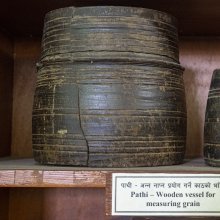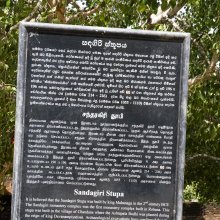Pathin, Paṭhi, Pathi, Pāṭhin, Pathī: 30 definitions
Introduction:
Pathin means something in Buddhism, Pali, Hinduism, Sanskrit, Jainism, Prakrit, the history of ancient India, Marathi, Hindi, biology. If you want to know the exact meaning, history, etymology or English translation of this term then check out the descriptions on this page. Add your comment or reference to a book if you want to contribute to this summary article.
Images (photo gallery)
In Hinduism
Purana and Itihasa (epic history)
Source: valmikiramayan.net: Srimad Valmiki RamayanaPathin (पथिन्) refers to the “pathways” (in the forest), according to the Rāmāyaṇa chapter 2.28. Accordingly:—“[...] soothening with kind words to Sītā, when eyes were blemished with tears, the virtuous Rāma spoke again as follows, for the purpose of waking her turn back: ‘[...] Snakes dwelling in rivers, moving crookedly like rivers, stay obstructing the pathways (pathin). Hence, living in forest is a great misery’”.

The Purana (पुराण, purāṇas) refers to Sanskrit literature preserving ancient India’s vast cultural history, including historical legends, religious ceremonies, various arts and sciences. The eighteen mahapuranas total over 400,000 shlokas (metrical couplets) and date to at least several centuries BCE.
Jyotisha (astronomy and astrology)
Source: Wisdom Library: Brihat Samhita by VarahamihiraPāṭhin (पाठिन्) refers to “one who is learned”, according to the Bṛhatsaṃhitā (chapter 2), an encyclopedic Sanskrit work written by Varāhamihira mainly focusing on the science of ancient Indian astronomy astronomy (Jyotiṣa).—Accordingly, “[...] He who loves prosperity ought not to live in a country devoid of a Jyotiṣaka. He (the Jyotiṣaka) forms as it were the eye of the land and where he dwells, sins exist not. A learned Jyotiṣaka [i.e., pāṭhin] not only escapes hell but (after death) goes to the Brahma-loka and obtains salvation”.

Jyotisha (ज्योतिष, jyotiṣa or jyotish) refers to ‘astronomy’ or “Vedic astrology” and represents the fifth of the six Vedangas (additional sciences to be studied along with the Vedas). Jyotisha concerns itself with the study and prediction of the movements of celestial bodies, in order to calculate the auspicious time for rituals and ceremonies.
Ayurveda (science of life)
Nighantu (Synonyms and Characteristics of Drugs and technical terms)
Source: WorldCat: Rāj nighaṇṭuPāṭhī (पाठी) is another name for Citraka, a medicinal plant identified with (1) [white variety] Plumbago zeylanica Linn.; (2) [red variety] Plumbago rosea Linn. syn. or Plumbago indica Linn., both from the Plumbaginaceae or “leadwort” family of flowering plants, according to verse 6.43-45 of the 13th-century Raj Nighantu or Rājanighaṇṭu.—The sixth chapter (pippalyādi-varga) of this book enumerates ninety-five varieties of plants obtained from the market (paṇyauṣadhi). Together with the names Pāṭhī and Citraka, there are a total of twenty Sanskrit synonyms identified for this plant.

Āyurveda (आयुर्वेद, ayurveda) is a branch of Indian science dealing with medicine, herbalism, taxology, anatomy, surgery, alchemy and related topics. Traditional practice of Āyurveda in ancient India dates back to at least the first millenium BC. Literature is commonly written in Sanskrit using various poetic metres.
In Buddhism
Tibetan Buddhism (Vajrayana or tantric Buddhism)
Source: academia.edu: Holy Sites in Buddhist Saṃvara CyclePathī (पथी) refers to one of the sixty-four inner channels running through the nirmāṇacakra, according to the 10th century Ḍākārṇava chapter 15. Nirmāṇacakra is an inner circle of the shape of a lotus with sixty-four petals. This inner circle is visualized in one’s abdomen. The inner channels [viz., Pathī] run through the petals of these inner circles.

Tibetan Buddhism includes schools such as Nyingma, Kadampa, Kagyu and Gelug. Their primary canon of literature is divided in two broad categories: The Kangyur, which consists of Buddha’s words, and the Tengyur, which includes commentaries from various sources. Esotericism and tantra techniques (vajrayāna) are collected indepently.
In Jainism
General definition (in Jainism)
Source: The University of Sydney: A study of the Twelve ReflectionsPathin (पथिन्) refers to “(pure) path” (of liberation), according to the 11th century Jñānārṇava, a treatise on Jain Yoga in roughly 2200 Sanskrit verses composed by Śubhacandra.—Accordingly, “It goes along with [sentient beings to the other world], then it protects, produces benefit always [and], having saved [them] from the mire of life it sets [them] on the pure path (pathin—sthāpayatyamale pathi) [of liberation]. There is nothing like the doctrine which is productive of all prosperity, the root of the tree of bliss, beneficial, venerable and grants liberation”.
Synonyms: Mārga, Patha.

Jainism is an Indian religion of Dharma whose doctrine revolves around harmlessness (ahimsa) towards every living being. The two major branches (Digambara and Svetambara) of Jainism stimulate self-control (or, shramana, ‘self-reliance’) and spiritual development through a path of peace for the soul to progess to the ultimate goal.
India history and geography
Source: Cologne Digital Sanskrit Dictionaries: Indian Epigraphical GlossaryPāthi.—(IA 15), a territorial unit; same as pathaka. Note: pāthi is defined in the “Indian epigraphical glossary” as it can be found on ancient inscriptions commonly written in Sanskrit, Prakrit or Dravidian languages.
Source: Cologne Digital Sanskrit Dictionaries: Indian Epigraphical GlossaryPāṭhin.—(EI3 1), epithet or family name of Brāhmaṇas. Note: pāṭhin is defined in the “Indian epigraphical glossary” as it can be found on ancient inscriptions commonly written in Sanskrit, Prakrit or Dravidian languages.

The history of India traces the identification of countries, villages, towns and other regions of India, as well as mythology, zoology, royal dynasties, rulers, tribes, local festivities and traditions and regional languages. Ancient India enjoyed religious freedom and encourages the path of Dharma, a concept common to Buddhism, Hinduism, and Jainism.
Biology (plants and animals)
Source: Wisdom Library: Local Names of Plants and DrugsPathi in the Sanskrit language is the name of a plant identified with Solanum erianthum D. Don from the Solanaceae (Potato) family having the following synonyms: Solanum verbascifolium var. adulterinum. For the possible medicinal usage of pathi, you can check this page for potential sources and references, although be aware that any some or none of the side-effects may not be mentioned here, wether they be harmful or beneficial to health.
Source: Google Books: CRC World Dictionary (Regional names)1) Pathi in India is the name of a plant defined with Aglaia hiernii in various botanical sources. This page contains potential references in Ayurveda, modern medicine, and other folk traditions or local practices It has the synonym Aglaia hiernii King.
2) Pathi is also identified with Plumbago zeylanica It has the synonym Plumbago rosea L. (etc.).
Example references for further research on medicinal uses or toxicity (see latin names for full list):
· Flora of Southern Africa (1963)
· Prodr. Fl. SW. Afr. (1967)
· Species Plantarum (1762)
· Flora of Tropical East Africa, Plumbaginaceae (1976)
· Fontqueria (1987)
· Taxon (1979)
If you are looking for specific details regarding Pathi, for example chemical composition, side effects, diet and recipes, pregnancy safety, health benefits, extract dosage, have a look at these references.

This sections includes definitions from the five kingdoms of living things: Animals, Plants, Fungi, Protists and Monera. It will include both the official binomial nomenclature (scientific names usually in Latin) as well as regional spellings and variants.
Languages of India and abroad
Pali-English dictionary
Source: BuddhaSasana: Concise Pali-English Dictionarypaṭhi : (aor. of paṭhati) read; recited.

Pali is the language of the Tipiṭaka, which is the sacred canon of Theravāda Buddhism and contains much of the Buddha’s speech. Closeley related to Sanskrit, both languages are used interchangeably between religions.
Marathi-English dictionary
Source: DDSA: The Molesworth Marathi and English DictionaryPāṭhī (पाठी).—a (pāṭha S) That, on reading, soon acquires by heart. 2 That can repeat from memory; esp. that can repeat the Vedas.
--- OR ---
pāthī (पाथी) [or पांथी, pānthī].—f A share of some common concern.
Source: DDSA: The Aryabhusan school dictionary, Marathi-EnglishPāṭhī (पाठी).—a That, on reading, soon acquires by heart. That can repeat from me- mory.
Marathi is an Indo-European language having over 70 million native speakers people in (predominantly) Maharashtra India. Marathi, like many other Indo-Aryan languages, evolved from early forms of Prakrit, which itself is a subset of Sanskrit, one of the most ancient languages of the world.
Sanskrit dictionary
Source: DDSA: The practical Sanskrit-English dictionaryPaṭhi (पठि).—f. Reading, studying, perusal.
Derivable forms: paṭhiḥ (पठिः).
Source: DDSA: The practical Sanskrit-English dictionaryPathin (पथिन्).—m. [path-ādhāre ini] (Nom. panthāḥ, panthānau, panthānaḥ; acc. pl. pathaḥ; instr. pl. pathibhiḥ &c.; the word is changed to patha at the end of comp.; toyādhārapathaḥ, dṛṣṭipathaḥ, naṣṭapathaḥ, satpathaḥ, pratipatham &c.)
1) A road, way, path; श्रेयसामेष पन्थाः (śreyasāmeṣa panthāḥ) Bhartṛhari 2.26; वक्रः पन्थाः (vakraḥ panthāḥ) Meghadūta 27.
2) Journey, way-faring, as in शिवास्ते सन्तु पन्थानः (śivāste santu panthānaḥ) '(I wish) a happy journey to you ! God speed you on your journey !'
3) Range, reach; as in कर्णपथ, श्रुति°, दर्शन° (karṇapatha, śruti°, darśana°).
4) Manner of action, line of conduct, course of behaviour; पथः शुचेर्दर्शयितार ईश्वरा मलीमसामाददते न पद्धतिम् (pathaḥ śucerdarśayitāra īśvarā malīmasāmādadate na paddhatim) R.3.46; न्याय्यात् पथः प्रविचलन्ति पदं न धीराः (nyāyyāt pathaḥ pravicalanti padaṃ na dhīrāḥ) Bhartṛhari 2.83.
5) A sect, doctrine.
6) A division of hell; Manusmṛti 4.9.
--- OR ---
Pāṭhin (पाठिन्).—a. [paṭh-ṇini]
1) One who has read or studied any subject.
2) Knowing or familiar with. -m. A Brāhmaṇa who has finished his studies.
Source: Cologne Digital Sanskrit Dictionaries: Shabda-Sagara Sanskrit-English DictionaryPaṭhi (पठि).—f. (-ṭhiḥ-ṭhī) Reading, perusal. E. paṭh to read, aff. in, ṅīṣ optionally added.
Source: Cologne Digital Sanskrit Dictionaries: Shabda-Sagara Sanskrit-English DictionaryPathin (पथिन्).—m. (panthā) 1. A road, a way. 2. Sect, doctrine, path in morals or religion. 3. A division of hell. 4. A journey. 5. Course of manner or action. E. path to go, in Unadi aff.; the noun is irregularly inflected.
--- OR ---
Pāṭhin (पाठिन्).—m. (-ṭhī) 1. A plant. (Plumbago zeylanica.) 2. A Brahman, especially one who has finished his sacred studies. E. pāṭha perusal, and ini aff.; the virtues of the plant are to be read of in medical works.
Source: Cologne Digital Sanskrit Dictionaries: Benfey Sanskrit-English DictionaryPathin (पथिन्).—for panthan (cf. paripanthin), which is the base of some cases, the bases of some others is path, the nom. and voc. sing. panthās, m. 1. A road, a way, [Meghadūta, (ed. Gildemeister.)] 28. 2. The name of a hell, [Mānavadharmaśāstra] 4, 90.
--- OR ---
Pāṭhin (पाठिन्).—i. e. pāṭha + in, adj. 1. Having studied, Mahābhārata 5, 1668. 2. Conversant with.
Source: Cologne Digital Sanskrit Dictionaries: Cappeller Sanskrit-English DictionaryPathi (पथि).—([nominative] panthās) path, road, course, way, manner; a cert. hell.
— panthānaṃ dā give the way to, go out of the way of ([genetive]). pathi in the way, on the journey; pathānena in this way or manner.
--- OR ---
Pathi (पथि).—v. path.
Source: Cologne Digital Sanskrit Dictionaries: Cappeller Sanskrit-English DictionaryPāṭhin (पाठिन्).—[adjective] well-read in (—°); [masculine] student, scholar.
Source: Cologne Digital Sanskrit Dictionaries: Monier-Williams Sanskrit-English Dictionary1) Paṭhi (पठि):—[from paṭh] f. = paṭhana, [cf. Lexicographers, esp. such as amarasiṃha, halāyudha, hemacandra, etc.]
2) Pathi (पथि):—[from path] 1. pathi for pathin in [compound]
3) [from path] 2. pathi [locative case] of pathin in [compound]
4) Pathī (पथी):—[from path] See ā-pathī.
5) Pāthi (पाथि):—[from pātha] m. the sun, [cf. Lexicographers, esp. such as amarasiṃha, halāyudha, hemacandra, etc.]
Source: Cologne Digital Sanskrit Dictionaries: Monier-Williams Sanskrit-English Dictionary1) Pathin (पथिन्):—[from path] m. (strong stem panthan, older panthā; middle pathi; weak path; sg. panthās ([nominative case] [vocative case]), panthānam [panthām, [Ṛg-veda; Atharva-veda]]; pathā, the, thas, thi; [dual number] panthānau, pathibhyām, pathos; [plural] panthānas [panthās, thāsas, [Ṛg-veda]; pathayas, [Brāhmaṇa]]; pathas [pāthas, [Ṛg-veda ii, 2, 4], perhaps [genitive case] sg.?]; pathibhis, bhyas; pathām [thīnām, [Ṛg-veda; Atharva-veda]]; pathiṣu; cf. [Pāṇini 7-1, 85 etc.]) a way, path, road, course ([literally] and [figuratively]; panthānaṃ-√dā, with [genitive case] to cede the way to; pathānena, ‘in this w° or manner’, pathi ni-√as See under ny-as), [Ṛg-veda] etc. etc.
2) [v.s. ...] range, reach (cf. karṇa-, darśanaetc.)
3) [v.s. ...] sect, doctrine, [cf. Lexicographers, esp. such as amarasiṃha, halāyudha, hemacandra, etc.]
4) [v.s. ...] a division of hell, [Manu-smṛti iv, 90]
5) [v.s. ...] Name of a teacher with the [patronymic] Saubhara, [Bṛhad-āraṇyaka-upaniṣad]
6) [v.s. ...] cf. patha; [Zend] panthan; [Greek] πάτος; [Latin] pont-em; Old [Prussian] pintis; [Slavonic or Slavonian] patĭ
7) Pāṭhin (पाठिन्):—[from pāṭha] mfn. one who has read or studied any subject
8) [v.s. ...] knowing, conversant with (ifc.), [Mahābhārata; Purāṇa]
9) [v.s. ...] m. a student
10) [v.s. ...] a Brāhman ([especially] one who has finished his sacred studies), [Horace H. Wilson]
11) [v.s. ...] Plumbago Zeylanica (also pāṭhī-kuṭa), [cf. Lexicographers, esp. such as amarasiṃha, halāyudha, hemacandra, etc.]
Source: Cologne Digital Sanskrit Dictionaries: Yates Sanskrit-English DictionaryPaṭhi (पठि):—(ṭhiḥ) 2. f. Reading, perusal.
Source: Cologne Digital Sanskrit Dictionaries: Yates Sanskrit-English Dictionary1) Pathin (पथिन्):—(nthā) 5. m. A road; sect; hell.
2) Pāṭhin (पाठिन्):—(ṭhī) 5. m. A plant (Plumbago zeylanica); a brāhman who has finished his sacred studies.
Source: DDSA: Paia-sadda-mahannavo; a comprehensive Prakrit Hindi dictionary (S)Pathin (पथिन्) in the Sanskrit language is related to the Prakrit words: Paṃtha, Paha.
[Sanskrit to German]
Sanskrit, also spelled संस्कृतम् (saṃskṛtam), is an ancient language of India commonly seen as the grandmother of the Indo-European language family (even English!). Closely allied with Prakrit and Pali, Sanskrit is more exhaustive in both grammar and terms and has the most extensive collection of literature in the world, greatly surpassing its sister-languages Greek and Latin.
Hindi dictionary
Source: DDSA: A practical Hindi-English dictionary1) Pathī (पथी):—(nm) see [pathika].
2) Pāṭhī (पाठी):——used as a suffix conveying the sense of a reader or scholar as [vedapāṭhī, maṃtrapāṭhī].
...
Kannada-English dictionary
Source: Alar: Kannada-English corpusPāṭhi (ಪಾಠಿ):—[noun] the under-shrub Plumbago zeylanica of Plumbaginaceae family; Ceylon lead wort.
Kannada is a Dravidian language (as opposed to the Indo-European language family) mainly spoken in the southwestern region of India.
See also (Relevant definitions)
Starts with (+20): Pathideya, Pathidruma, Pathikrit, Pathina, Pathinga, Pathinu, Pathiprajna, Pathivahaka, Pathyadena, Pathyashana, Patin-aintampuli, Patin-en-kilkanakku, Patin-en-kutimakkal, Patin-en-upapuranam, Patin-encittar, Patin-enkanam, Patin-enkannan, Patin-enkurram, Patin-enmoli, Patin-enpumi.
Ends with (+11): Aditya tripathin, Aghorapathin, Amalapathin, Apathin, Ardhapathin, Atipathin, Aturtapathin, Bahupathin, Balakrishna tripathin, Bhairava tripathin, Damodara tripathin, Dharmapathin, Drishtipathin, Lalamani tripathin, Madhukara tripathin, Pancapathin, Prapathin, Ramanandasharman tripathin, Rudra sharman tripathin, Rudramani tripathin.
Full-text (+409): Pathis, Pantha, Atipathin, Sahapathin, Aturtapathin, Apathin, Supathin, Paha, Patheya, Tarkupathi, Pathimat, Catushpathi, Pathiprajna, Pathidruma, Tripathin, Cakapati, Vedapathin, Aghorapathin, Pathivahaka, Pathyashana.
Relevant text
Search found 40 books and stories containing Pathin, Paṭhi, Pathi, Pāṭhin, Pathī, Pathīn, Pāthī, Pāthi, Pāṭhī, Pāṭhi; (plurals include: Pathins, Paṭhis, Pathis, Pāṭhins, Pathīs, Pathīns, Pāthīs, Pāthis, Pāṭhīs, Pāṭhis). You can also click to the full overview containing English textual excerpts. Below are direct links for the most relevant articles:
Garga Samhita (English) (by Danavir Goswami)
Verse 8.13.88 < [Chapter 13 - A Thousand Names of Lord Balarāma]
Verse 5.5.37 < [Chapter 5 - Śrī Kṛṣṇa’s Entrance Into Mathurā]
Verse 6.14.27 < [Chapter 14 - The Glories of Ratnākara, Raivata, and Kācala]
Rig Veda (translation and commentary) (by H. H. Wilson)
Bhakti-rasamrta-sindhu (by Śrīla Rūpa Gosvāmī)
Verse 3.4.35 < [Part 4 - Parenthood (vātsalya-rasa)]
Verse 3.1.40 < [Part 1 - Neutral Love of God (śānta-rasa)]
Verse 1.2.240 < [Part 2 - Devotional Service in Practice (sādhana-bhakti)]
Manusmriti with the Commentary of Medhatithi (by Ganganatha Jha)
Verse 4.88-90 < [Section X - Gifts not to be Accepted]
Verse 9.274 < [Section XXXVIII - Treatment of Criminals and their Punishment]
Verse 8.240 < [Section XXXIX - Disputes between Owner and Keeper]
Hari-bhakti-kalpa-latikā (by Sarasvati Thkura)
Text 27 < [First Stabaka]



